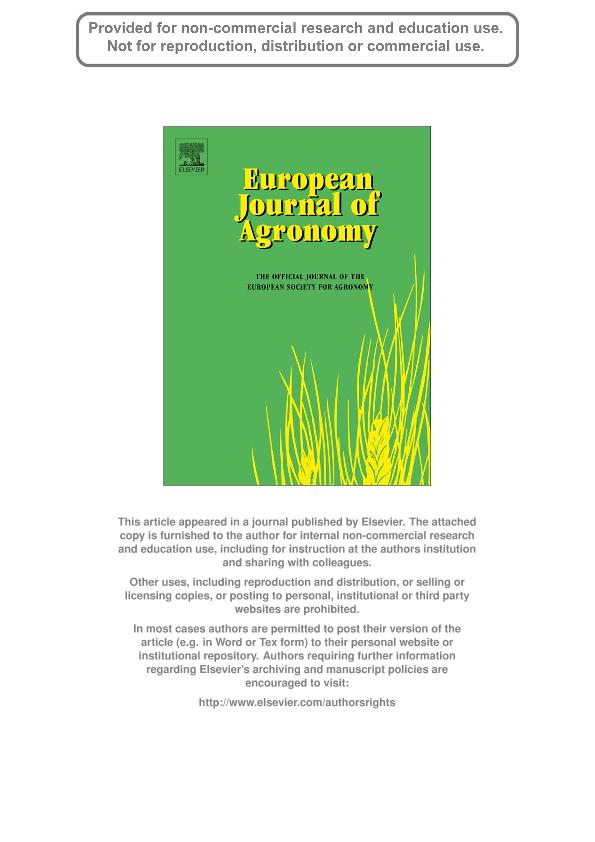Artículo
Environmental factors affecting yield variability in spring and winter rapeseed genotypes cultivated in the southeastern Argentine Pampas
Fecha de publicación:
07/2013
Editorial:
Elsevier Science
Revista:
European Journal Of Agronomy
ISSN:
1161-0301
Idioma:
Inglés
Tipo de recurso:
Artículo publicado
Clasificación temática:
Resumen
Rapeseed yields in Argentina are low (averaging 1400 kg/ha nationwide) with a high inter-annual variability. One of the limiting factors for improving yields is the lack of information on the adaptability of the cultivars, especially in the main rapeseed-producing area, the southeastern Pampas. The objectives of this study were to (i) quantify and analyze the yield variability of winter and spring rapeseed hybrids introduced in Argentina, (ii) identify the main environmental factors that affect the yields of the spring and winter genotypes in the southeastern Pampas, and (iii) model and validate rapeseed yields from environmental variables in the pre- and post-flowering periods. Principal component analysis (PCA) and linear regression methods were used to analyze 129 data points from 16 comparative yield trials in eight sites of southeastern Pampas. The rainfed crops were sown between April and July and from 2007 to 2009. Pre- and post-flowering phases were recorded in each experiment; temperature, frost occurrences, rainfall and radiation were measured during each phase. Yield variability (600–3700 kg ha−1) was slightly lower in spring than in winter genotypes (CV 0.25 versus 0.38). Sixty percent of the winter genotype variability was explained by the first axis which was associated to the pre- and post-flowering durations, while 25% of the variability was explained by the second axis associated to yield. Almost 50% of the spring genotype variability was explained by the first axis associated to pre-flowering and total durations, while 27% of the variability was explained by the second axis in which post-flowering duration was associated to yield. Winter genotypes evidenced vernalization requirements that were either partially or not fulfilled, so, the longer the photoperiod, the longer the pre-flowering phase duration. In the critical period of 30 d post-flowering, yield was not associated to the photothermal quotient. In winter genotypes, yield was associated to a linear model which included rainfall during the crop cycle, radiation and pre-flowering temperatures (R2 = 0.50). The model was adequately validated with independent data (n = 116) from official trials. For spring genotypes, only the frost occurrences during the critical period were relevant (R2 = 0.26) and placing the flowering time after October decreased the risk of late frost damage. Water use efficiency (WUE) values ranged from 1.6 to 6.7 kg ha−1 per mm of rain without a clear trend between spring and winter genotypes for this trait. In conclusion, winter genotypes did not necessarily yield more than the spring materials. In addition, rainfall during the crop cycle and frost occurrences during flowering were the main limiting factors of the winter and spring genotype yields, respectively, in the southeastern Pampas.
Palabras clave:
Rapeseed
,
Genotype
,
Environment
Archivos asociados
Licencia
Identificadores
Colecciones
Articulos(IFEVA)
Articulos de INST.D/INV.FISIOLOGICAS Y ECO.VINCULADAS A L/AGRIC
Articulos de INST.D/INV.FISIOLOGICAS Y ECO.VINCULADAS A L/AGRIC
Citación
Takashima, Nicolás E.; Rondanini, Deborah Paola; Puhl, Laura E.; Miralles, Daniel Julio; Environmental factors affecting yield variability in spring and winter rapeseed genotypes cultivated in the southeastern Argentine Pampas; Elsevier Science; European Journal Of Agronomy; 48; 7-2013; 88-100
Compartir
Altmétricas




